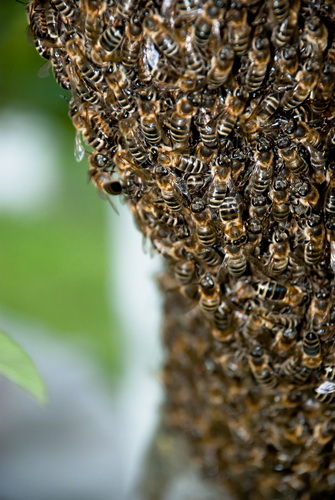In the News – Honey Bee Colony Collapse Disorder
By Chris Williams on March 10, 2013.
 Honey bees have been disappearing at an alarming rate in the U.S. since 2006 and experts have yet to figure out why. They’ve given the phenomenon the name, Colony Collapse Disorder or CCD. It’s really pretty spooky. Most, if not all, of the adult bees in a colony will simply disappear, leaving behind their queen, their honey, and hungry bee larvae, but there are no dead bee bodies in the hive. Most beekeepers report that they lose about 30% of their colonies every year. We are all guilty of taking honey bees for granted. Their value in pollinating our food crops is immeasurable.
Honey bees have been disappearing at an alarming rate in the U.S. since 2006 and experts have yet to figure out why. They’ve given the phenomenon the name, Colony Collapse Disorder or CCD. It’s really pretty spooky. Most, if not all, of the adult bees in a colony will simply disappear, leaving behind their queen, their honey, and hungry bee larvae, but there are no dead bee bodies in the hive. Most beekeepers report that they lose about 30% of their colonies every year. We are all guilty of taking honey bees for granted. Their value in pollinating our food crops is immeasurable.
Many possible causes for CCD have been proposed, reported, and studied—but no definitive answer has yet been found. Different interest groups campaign for different causes. Anti-pesticide folks point the finger at pesticides. Global warming advocates say it’s the weather. Even cell phone towers are blamed. The best guess is that honey bee colony collapse is a result of a combination of factors, yet to be determined.
These are some of the ideas currently being investigated:
Parasites and diseases
Certain mites are known to attach to and feed on honey bees, causing decline and mortality. These mites also spread viruses to the honey bees which weakens them further and may make them more vulnerable to other stresses.
Pesticides
Because they are intimately associated with crops, honey bees are exposed to a number of pesticides. Fingers have been pointed at the neonicotinoid pesticides especially. These pesticides, while still used in the U.S., have been banned in France and Germany for a number of years, but these countries still have CCD problems.
Stresses associated with commercial beekeeping
Many commercial beekeepers rent out their honey bees for pollination of crops. Transportation on tractor trailers, exposure to other diseases, and being limited to a single nectar source all stress these traveling, working bees.
Global climate changes
Having to adapt to milder winters, early springs, drought, flooding, and earlier bloom dates may take a toll on bees.
Genetically modified crops
Exposure to genetically modified Bt corn has been offered as a cause of CCD. But there is no correlation between CCD and areas where Bt corn is planted or the timing of Bt corn introduction.
Please don’t confuse honey bees with yellowjackets. Yellowjackets are mostly ground nesters that can become very annoying and aggressive in the fall. Honey bees are much more docile and are not the ones ruining your barbecue. Honey bees are usually only a problem if they happen to be nesting in a building void or if they form a swarm in a public location, or if you interfere with their nest.
If you’re having a problem with yellowjackets in your yard, give Colonial a call. Our technicians know the difference between honey bees and yellowjackets, and will locate and treat the yellowjacket nests.